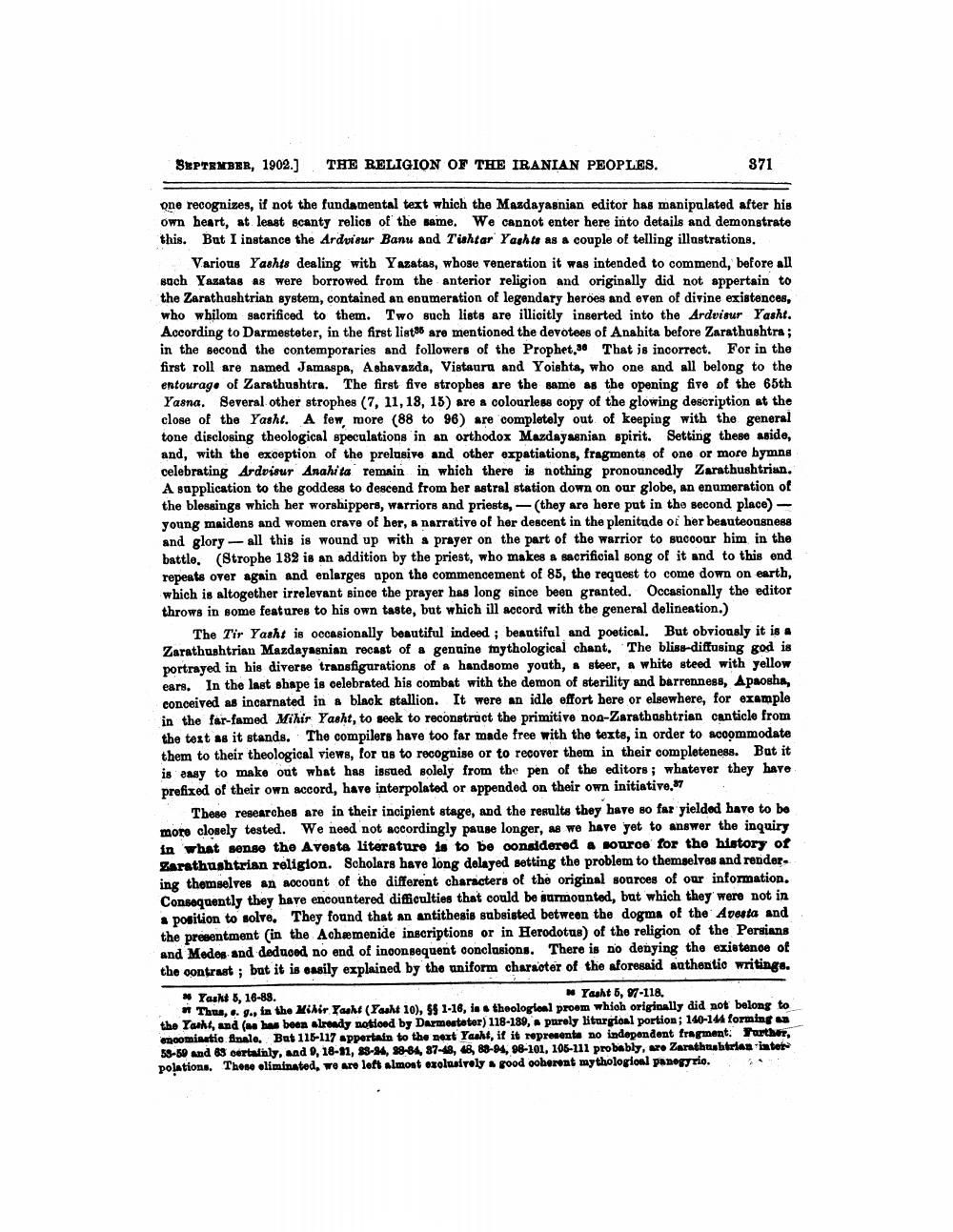________________
SEPTEMBER, 1902.)
THE RELIGION OF THE IRANIAN PEOPLES.
871
one recognizes, if not the fundamental text which the Mazdayasnian editor has manipulated after his own heart, at least scanty relics of the same. We cannot enter here into details and demonstrate this. But I instance the Ardvisur Banu and Tishtar Yasht as a couple of telling illustrations.
Various Yashts dealing with Yazatas, whose veneration it was intended to commend, before all such Yazatas A8 were borrowed from the anterior religion and originally did not appertain to the Zarathushtrian system, contained an enumeration of legendary heroes and even of divine existences, who whilom sacrificed to them. Two such lists are illicitly inserted into the Ardvisur Yasht. According to Darmesteter, in the first ligt86 are mentioned the devotees of Anahita before Zarathushtra; in the second the contemporaries and followers of the Prophet 36 That is incorrect. For in the first roll are named Jamaspa, Ashavazda, Vistaura and Yoishta, who one and all belong to the entourage of Zarathushtra. The first five strophes are the same as the opening five of the 65th Yasna. Several other strophes (7, 11, 13, 15) are a colourless copy of the glowing description at the close of the Yasht. A few, more (88 to 96) are completely out of keeping with the general tone disclosing theological speculations in an orthodox Mazdayasnian spirit. Setting these aside, and, with the exception of the prelusive and other expatiations, fragments of one or more bymng celebrating Ardvisur Anahi ta remain in which there is nothing pronouncedly Zarathushtrian. A sapplication to the goddess to descend from her astral station down on our globe, an enumeration of the blessings which her worshippers, warriors and priests, -(they are here put in the second place) young maidens and women crave of her, a narrative of her descent in the plenitude of her beauteousness and glory - all this is wound up with a prayer on the part of the warrior to sucooar him in the battle. (Strophe 182 is an addition by the priest, who makes a sacrificial song of it and to this end repeats over again and enlarges upon the commencement of 85, the request to come down on earth, which is altogether irrelevant since the prayer has long since been granted. Occasionally the editor throws in some features to his own taste, but which ill accord with the general delineation.)
The T'ir Yasht is occasionally beautiful indeed; beantiful and poetical. But obviously it is a Zarathushtrian Mazdayasnian recast of a genuine mythological chant. The bliss-diffusing god is portrayed in his diverse transfigurations of a handsome youth, & steer, a white steed with yellow ears. In the last shape is celebrated his combat with the demon of sterility and barrenness, Apaosha, conceived as incarnated in a black stallion. It were an idle effort here or elsewhere, for example in the far-famed Mihir Yasht, to seek to reconstruct the primitive non-Zarathashtrian canticle from the text as it stands. The compilers have too far made free with the texts, in order to acoommodate them to their theological views, for us to recognise or to recover them in their completeness. But it is easy to make out what has issued solely from the pen of the editors; whatever they have prefixed of their own accord, have interpolated or appended on their own initiative,87
These researches are in their incipient stage, and the results they have so far yielded have to be more closely tested. We need not accordingly pause longer, as we have yet to answer the inquiry in what sense the Avesta literature is to be considered a source for the history of Zarathushtrian religion. Scholars have long delayed setting the problem to themselves and render. ing themselves an account of the different characters of the original sources of our information. Consequently they have encountered difficulties that could be surmounted, but which they were not in
position to solve. They found that an antithesis subsisted betweon the dogma of the Adesta and the presentment in the Achæmenide inscriptions or in Herodotus) of the religion of the Persians and Modes and deduoed no end of inconsequent conclusions. There is no denying the existence of the contrast ; but it is oasily explained by the uniform character of the aforesaid authentic writings. * Tasht 8, 16-88.
Yasht 5, 97-118, Thus,.. ., in the Minir Yashi (Yacht 10), 591-16, ie. theologloul proem which originally did not belong to the Yashf, and (on how been already noticed by Darmostater) 118-189, purely largioal portion; 140-144 forming sa enoomiaatio Analo. Bat 116-117 ppertain to the next Yaaht, if it representa no independent fragment. Tarther, 58-59 and 63 certainly, and , 18-11, 83-84, 89-84, 87-48, 48, 88-94, 96-101, 106-111 probably, aro Zarathushtrian inter polations. These eliminated, we are loft almont oxola voly good coherent mythologioul panegyrio.




